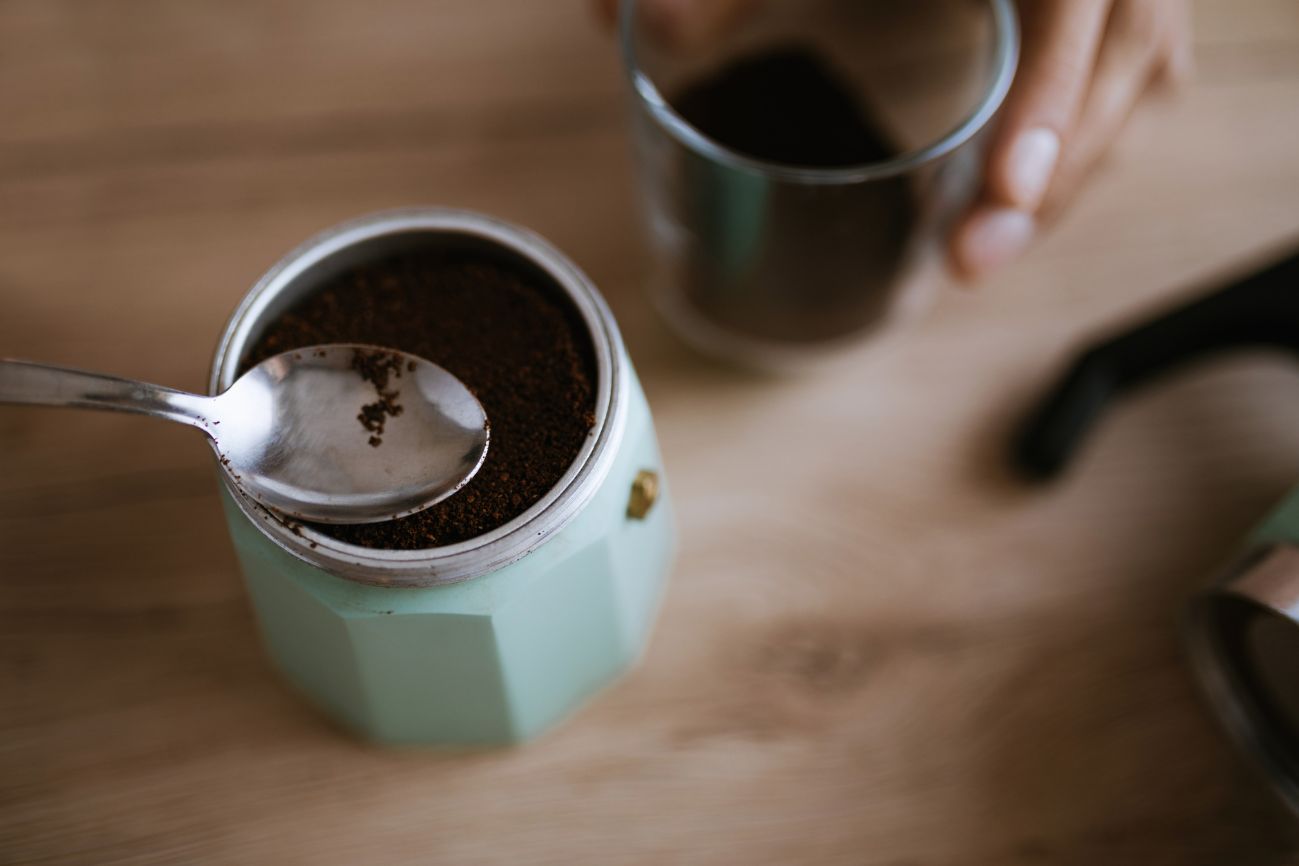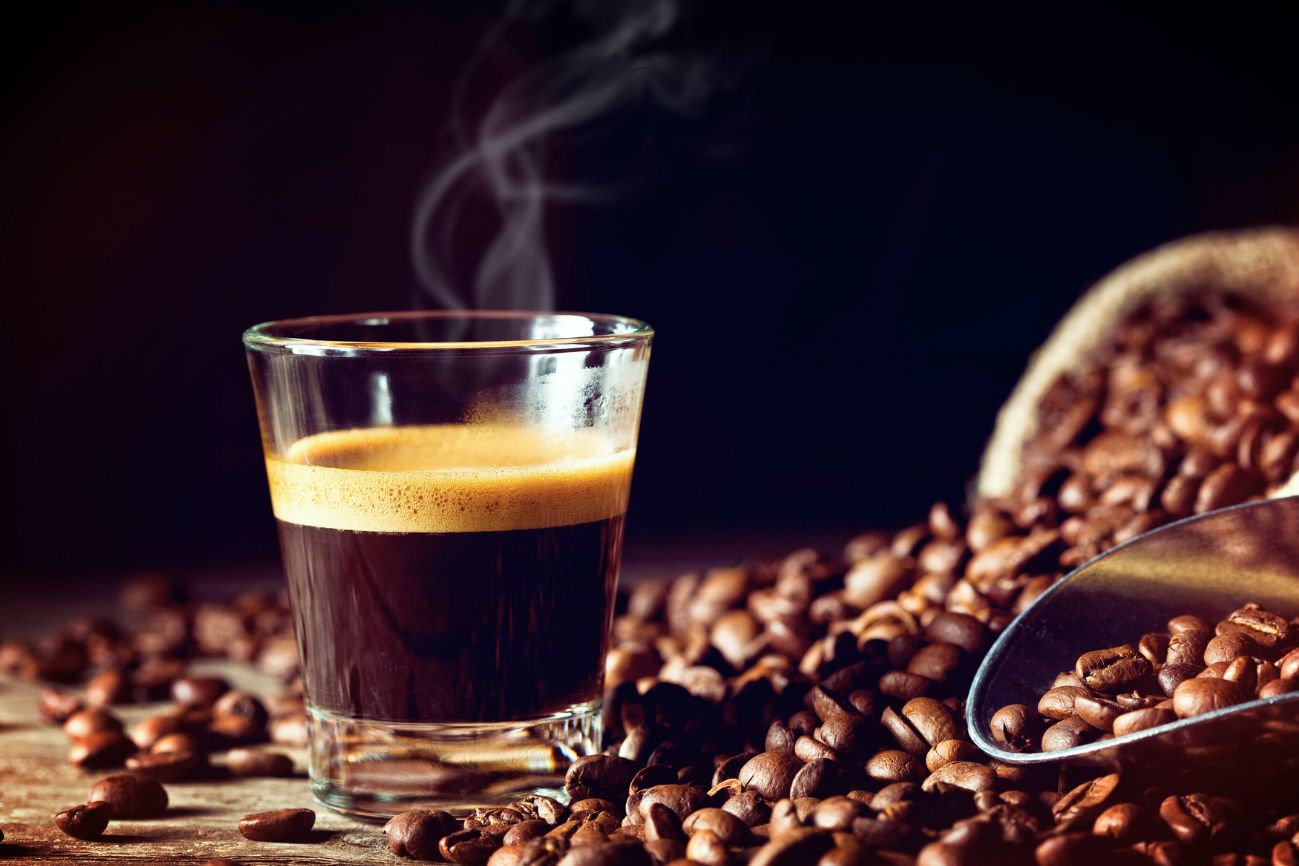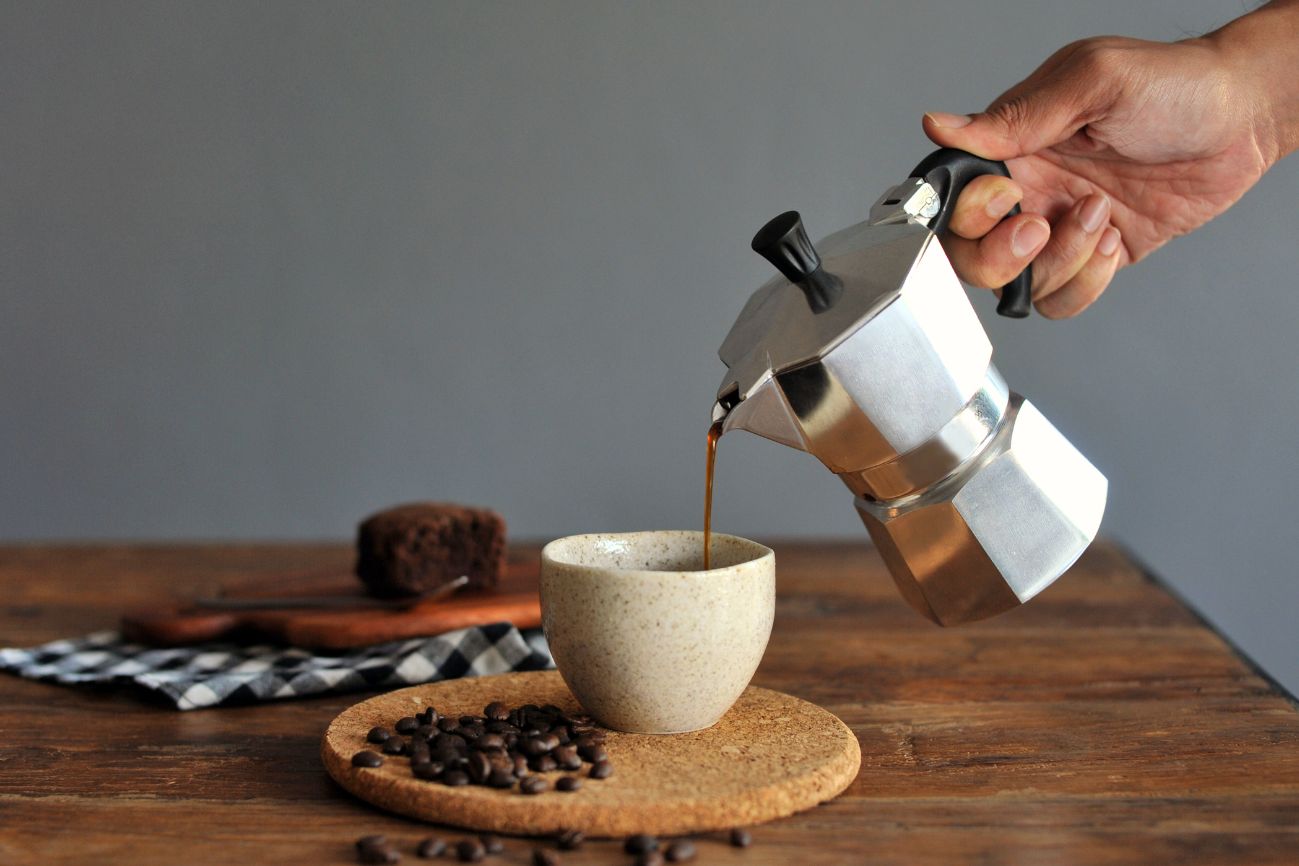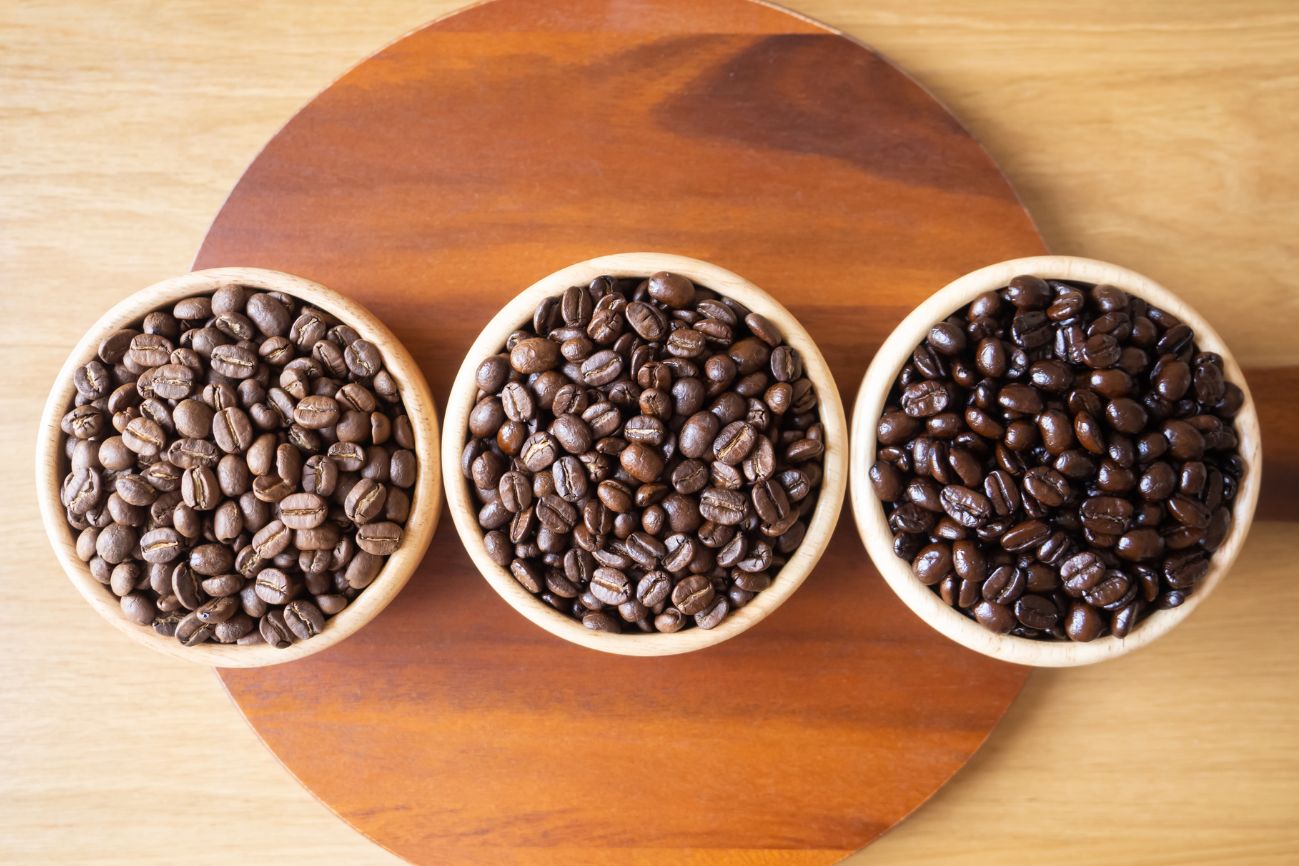The humble Moka pot is an iconic piece of Italian coffee culture and a staple for strong espresso like coffee at home. Whether you’re a beginner or a daily brewer, mastering this stovetop device can completely upgrade your morning cup. In this guide, we’ll share 20 practical Moka pot tips and hacks plus FAQs to help you troubleshoot, improve taste, and make brewing faster, cleaner, and more enjoyable.
Moka Pot Tips & Hacks
1. Preheat the Water
Boiling water in a kettle and pouring into maka pot’s bottom chamber is an extra step on your Moka pot process but it’s well worth it. You will enjoy a more smoother and cleaner taste of coffee.
- Reduces brewing time: Preheated water means less time on the stove, so your coffee brews faster.
- Prevents bitter flavors: The longer your Moka pot sits on the heat, the more the coffee grounds can over-extract and produce a burnt or metallic taste. Starting with hot water minimizes this risk.
- Protects the coffee grounds: When you start with cold water, the metal pot gets very hot before the water boils, which can overheat the coffee basket prematurely. Preheated water with higher-quality beans, will elevate the coffee taste more clean chocolatey, nutty or fruity flavor in your cup.
If you want to compare the differences, try this simple taste test:
- Brew one batch with preheated water and another with cold.
- Use the same coffee, grind size, and heat level.
- Taste side by side (ideally black, no milk or sugar).
- Notice mouthfeel, bitterness, acidity, and overall balance.
Tip: Use a small towel or oven mitt when handling the bottom chamber after adding hot water to avoid your hands get burned, it gets hot fast!
2. Use Filtered Water
Even you drink tap water in daily life, we recommend starting with clean, filtered water for brewing coffee. Tap water with too much chlorine or limescale can ruin the flavor and damage your pot over time.
- Removes chlorine and chemicals: Tap water often contains chlorine or other disinfectants that can make coffee taste flat, bitter, or even slightly chemical-like.
- Reduces hardness (minerals like calcium & magnesium): Hard water can cause limescale in your equipment and dull flavor clarity. But some minerals are good for extraction, so it’s about balance (see next section).
- Improves flavor clarity and balance: Along with the preheated water, the filtered water allows the true notes of your beans to shine, whether that’s fruity acidity, nutty smoothness, or chocolatey richness.
3. Grind Right
Use a medium-fine grind which is coarser than espresso but finer than drip. Too fine = bitter; too coarse = weak. Check this our article about the Ultimate Coffee Grinding Guide.
4. Master the “Three‑Quarter” Fill Trick
Rather than heaping the coffee, fill it to just below the rim (about ¾ full) and level it with a finger, or the back of a spoon. This leaves room for coffee expansion and better water circulation. Never tamp like espresso. It builds up too much pressure and risks clogging.
5. Fill Water to the Valve, Not Above
That little safety valve is there for a reason. Never cover it! Overfilling can cause dangerous pressure buildup.
6. Use Fresh Beans
Freshly roasted beans (used within 2–4 weeks of roasting) offer the richest aroma and flavor. Grind right before brewing.
7. Brew with Low Medium Heat
Use low to medium heat that is enough to slowly build pressure but not so hot that it scorches the coffee or boils too fast. The ideal temperature range is 158–194°F (70–90°C) inside the pot during extraction. The water itself boils at 212°F (100°C), but you don’t want rapid boiling. High heat may scorch your coffee or cause it to sputter. Go slow and steady for a smoother brew.
8. Remove from Heat Early
Once you hear a gurgling sound, remove the pot from heat and let the residual pressure finish brewing. This avoids overheating and brings out smoother flavor.
9. Use a Wet Towel or cold water to Cool Quickly
As soon as remove the pot from the heat, wrap the bottom chamber with a cold towel or run it under cold water to stop brewing instantly to prevent bitterness from overheating.
10. Stir Before Serving
Coffee can be more concentrated at the bottom. We recommend you to stir the brewed coffee with a spoon before pouring for balanced flavor.
11. Don’t Use Soap
Just rinse with warm water without soap and dry completely. Soap can affect flavor and damage aluminum. Brush or rub the moka pot lightly if you want to clean the colored surface.
12. Descale Every Month
Mineral can buildup from the tap water in every wash, it affects the moka pot performance. Use a 1:1 vinegar and water mix every few weeks to descale.
13. Replace Gaskets & Filters
If the rubber gasket looks cracked or the filter plate is warped, you need to replace them. Most replacement parts are cheap and easy to find. If you have Bialetti Moka Express 6 Cup, check this on Amazon.
14. Store It Dry and Disassembled
After cleaning the moka pot, always dry completely before store it. Moisture buildup inside can cause mold or odors. Also it’s better store unassembled if possible.
15. Tame Bitterness with a Pinch of Salt
Yes, salt! A small pinch can cut bitterness and enhance sweetness, especially useful with darker roasts. Adding a tiny pinch of salt to your Moka pot grounds is a simple hack to smooth out harsh, over‑extracted notes and enhance perceived sweetness:
- Why it works: Salt ions bind with bitterness compounds (like chlorogenic acid breakdown products), reducing their impact on your taste buds. Meanwhile, salt also heightens sweetness and roundness in the cup.
- How much to use: Aim for no more than 1/16 teaspoon (≈0.3 g) of fine table or sea salt per full Moka pot brew. Too much salt will flavour the coffee overtly, so go very light.
- When to add: Sprinkle the salt evenly onto your coffee grounds before placing the basket into the pot. Gently give the grounds a light swirl to distribute it uniformly.
- Salt type: Fine sea salt, table salt or Himalayan pink salt all work; avoid coarse grains, which won’t dissolve fully.
- Taste test: Try two identical brews—one with salt, one without—to calibrate how much salt suits your palate.
16. Use a Paper Filter Hack
Place a circular paper filter (AeroPress or cut from a drip filter) over the coffee basket to reduce grit and clarify flavor. Adding a simple paper‑filter layer to your Moka pot brew can dramatically improve clarity and reduce gritty sediment.
- Why it works: Catches the finest grounds and oils, leaving you with a smoother, clearer extraction. By removing excess fines and oils, delicate aromatics and sweetness shine through.
- How to do it: Use a standard Melitta‑style drip filter and cut a circle slightly larger than your Moka basket. Lay the paper disc directly on top of your levelled coffee grounds. Assemble and heat your Moka pot per your usual routine.
- Tips for Success: Don’t compress the filter on the grounds so water can flow freely. Use unbleached paper to minimises any off‑flavours from the filter itself.
17. Try the “Bloom” Technique
While blooming is most often associated with pour‑over methods, you can adapt a similar pre‑infusion step to your Moka pot to coax out brighter aromas and improve extraction consistency. Pour just a little water and let the coffee puff up (like in pour-over) before brewing fully. This will help unlock flavor compounds.
18. Warm Your Cup
A cold cup can dull flavor. Rinse your mug with hot water before pouring your Moka pot brew.
19. Experiment with Coffee Blends & Ratios
Single‑origin beans showcase terroir, while blends balance acidity, body and sweetness. For a syrupy result, add a small proportion (10–15 %) of a dark roast to your regular medium roast. Also adjust brew ratio (coffee to water by weight), for standard, 1:7–1:8, for more intensity, try 1:6 and for a lighter brew, 1:9.
20. Enhance with Aromatic Boosters
- Spice infusion: Add a pinch of cardamom or cinnamon to the grounds for an exotic twist, it’s common in Middle Eastern coffee traditions.
- Cocoa: A teaspoon of unsweetened cocoa in the basket can yield mocha‑style notes.
Frequently Asked Questions About the Moka Pot
Q: Is Moka Pot Coffee Stronger Than Drip Coffee?
A: Yes. Moka pot coffee is more concentrated than drip but not quite as strong as espresso. It usually has more body and bolder flavor.
Q: What type of fltered water to Use at Home?
A: You can use simply like Brita or, PUR water filter pitcher. A bottled spring water is often well-balanced for coffee. The best water for coffee but not essential for daily use is specialty coffee water like Third Wave Water sachets. If you have speciality coffee beans, well worth to try it!
Q: Should I tamp the coffee like an espresso?
A: No. Lightly level it with your finger or spoon, but don’t press it down.
Q: Can I use Moka pots on induction stovetops?
A: Only if the base is magnetic (like stainless steel). Aluminum Moka pots won’t work on induction unless paired with an adapter.
Q: Why does my coffee taste metallic or burnt?
A: Overheating, stale coffee, or tap water can cause this. Try filtered water, fresh beans, and medium heat.
Q: Can I put it in the dishwasher?
A: No, especially not aluminum pots. Hand-wash only to preserve the finish and prevent corrosion.
Q: How often should I replace the gasket?
A: Every 3–6 months if used daily. Check for wear or leaks.
Q: Can I use flavored coffee or pre-ground beans?
A: Yes, but fresh, whole beans ground just before brewing will always taste better. Flavored grounds may also leave residue in your pot.
Quick Moka Pot Brew Checklist
Final Thoughts
The Moka pot is simple but powerful. A few small changes—like preheating water, dialing in grind size, or using filtered water—can transform your daily brew into something rich, bold, and satisfying.
Whether you’re chasing a café-like experience at home or just love strong stovetop coffee, these Moka pot tips, hacks, and FAQs will keep your brew consistent and delicious. Happy brewing!




